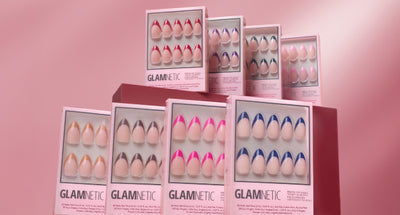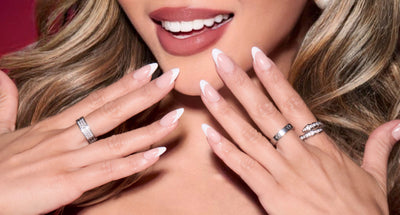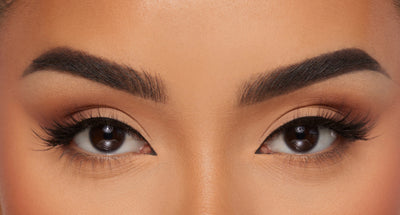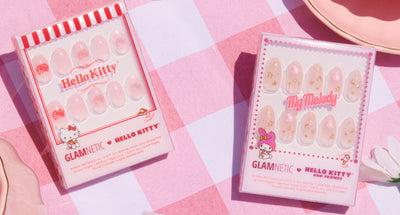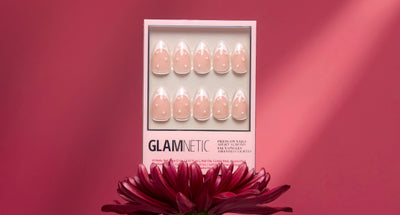Gel vs. Acrylic Nails: What’s the Difference?

When it comes to getting your nails done at the nail salon, there are tons of choices. Do you want long nails or short nails? Matte or glossy? The options are endless.
Unless you know which nail set you want, the choices can be overwhelming—so we’re here to help. We’ll explain the differences between gel nails and acrylic nails so you know what all your options are.

What Are Acrylic Nails?
Acrylic nails have become increasingly popular, with celebrities like Cardi B, Kylie Jenner, and Billie Eilish setting the nail trends. It’s only natural that you would want long, trendy nails too.
Acrylic nails are an extension of your natural nails, so they’re usually long or medium in length. For acrylic nails, your natural nails are filed down to create a rough surface for the acrylic to adhere to. A nail extension or nail form is applied to your natural nails to add the extra length to which the acrylic will be attached.
The surface of the nails must be filed and buffed first, and then an acrylic overlay is brushed on top of the nail extensions. The acrylic overlay combines a powder polymer and a liquid monomer. The powder and liquid are mixed to create a thick, pasty dough, which is painted onto your fingernails and the extension. The acrylic dries quickly and is shaped and buffed with a nail file and e-file drill.
From start to finish, the process can last 45 minutes or longer, especially if you have intricate nails designs, charms, or rhinestone designs applied to your nails. The options are endless when it comes to acrylic nail designs.
Of course, there are pros and cons to acrylic nails, so we’ll run you through a few of them.
Advantages of Acrylic
Acrylic nails reflect your individual style when you create a design. Here are some pros to getting acrylic nails.
- Acrylic nails last for two to three weeks before needing an acrylic refill.
- Acrylic nails are much harder than gel, leading to less chipping and breaking.
- Acrylic nails can be decorated with gemstones, charms, and other designs.
Disadvantages of Acrylic Nails
There are lots of pros to acrylic nails, but there are also some disadvantages. Here are a few.
- Acrylic nails require refills every two to three weeks.
- Acrylic nails can cause damage to your natural nails.
- Toxic chemicals are required to form the acrylic to your nails.
- To remove acrylic nails, they need to be soaked in acetone. Do not remove the nails at home, or you will risk permanent damage to the nail bed.
What Are Acrylic Refills?
During a refill, new acrylic will be laid where the regrowth of the new nail has grown in. The nails will be filed and buffed again, and a fresh coat of paint or shellac will be applied. Nail art will also be re-adhered by the nail tech.
This refill process will take place every two to three weeks until you are ready to completely remove the acrylic nails or get a new nail set.
Acrylic Nail Removal
Removing your acrylic nails is a process that must be performed at the nail salon to avoid damage to your natural nails. The process requires soaking your nails in acetone for several minutes. Soaking them will soften the acrylic so that it can be removed completely from your nails.

What Are Gel Nails?
Gel nail manicures are known for their long wear and glossy finishes. Gel nails are different from acrylic nails because they are not an extension of your nail.
The gel is a liquid lacquer that is painted on top of your natural nails. First, a special base coat is applied and cured under a UV or LED lamp, and then the gel color is applied. Finally, a special gel top coat finishes it off.
Each layer is cured and set under the UV or LED lamp. The whole process takes less than an hour. Gems and nail art can be added too!
The gel comes in all types of colors that last up to two weeks. However, just like acrylics, gel nails come with pros and cons.
Advantages of Gel Nails
Gel nails have their advantages, and some people may find their benefits better than acrylics.
- Gel nails do not damage your nails as much as acrylic nails do.
- The gel is applied by painting it right over your natural nails.
- Gel nails last for up to two weeks with no chipping.
- Gel nails are more flexible than acrylic nails.
Disadvantages of Gel Nails
As with anything you put over your natural nails, gel nails have their disadvantages too.
- To remove gel nails, you must soak your digits in acetone. However, acetone is drying, and that can cause peeling.
- Repeatedly covering your nails in gel may cause peeling and cracking of your natural nails.
- Your nails have to be filed down for the gel to adhere to the nail, which can weaken your natural nails.
Maintenance and Removal of Gel Nails
Gel nails usually need to be repainted every two to three weeks. Your nail tech will soak off the old gel and paint a new gel color onto your nails to replace it and maintain the super glossy finish.
The nail tech will soak your nails in acetone for about 15 minutes when you’re ready to remove your gel, just until the gel becomes soft enough to slide off. The nails will then be filed, buffed, and painted again in a different gel color.

Should You Choose Gel or Acrylic Nails?
Gel and acrylic nails both have their advantages and disadvantages. The difference is whether you want a long nail extension or gel paint over your natural nails. Both nail types last for about two to three weeks, but acrylic damages your nails much more than gel does.
Acrylic nails are longer, so adding bling and different nail art is easier on acrylic nail extensions. Consider Cardi B’s nails—she could never have those elaborately decorated nails unless they were ultra-long.
Regardless of which nails you choose, if you have a good nail tech, you should always end up with healthy nails in the end.
How to Choose a Nail Tech
Choosing a nail tech is super important. Every nail salon is held to its state’s health and safety guidelines.
Proper hygiene and sanitation practices are crucial in protecting your health and the health of others. Tools should be kept clean and dry, and specific tools should not be used between clients.
Conclusion
The difference between gel nails and acrylic is bigger than you might have thought. Acrylic nails offer length and the option for lots of elaborate nail gems, designs, and charms. Acrylic nails will also damage your natural nails much more than gel nails. However, both can be damaging. These nails are hard, so they’re difficult to break and chip.
Gel nails create a layer of painted gel over your natural nails. Each layer of gel is cured under a UV or LED light. Gel paint lasts much longer than regular nail polish—up to two to three weeks, but the gel contains harsh chemicals that can be absorbed through your natural nails.
Glamnetic press-on nails offer length and on-trend designs without the commitment or harsh chemicals of acrylic or gel. They don’t cause damage to your nails and take only two minutes to apply.
Ditch the nail salon and reach for Glamnetic press-on nails instead. They are much more affordable than going to the nail salon, and there are lots of trendy styles to choose from. Plus, Glamnetic nails are waterproof, chip-resistant, and reusable. Why would you do anything else with your nails?
Acrylic and gel nails are great if you want a commitment to one style for several weeks, but you can change Glamnetic press-on nail styles frequently without damage to your nails. Check out the nail quiz to find which Glamnetic style is your perfect fit!
Sources:
Laws and Regulations - California Board of Barbering and Cosmetology | Barber Cosmo
How to Achieve the Perfect Acrylic Mix Ratio | Nails Mag
Gel Nails - Everything You Need To Know About Getting Gel Manicures | Seventeen Magazine
♡SUBSCRIBE BELOW FOR 15% OFF YOUR GLAMNETIC PURCHASE!♡



